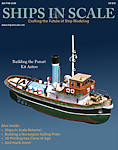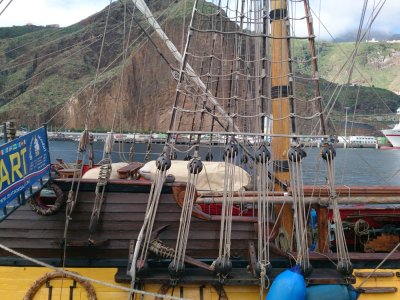How to mount the lanyards on the Vega boat:
-

Win a Free Custom Engraved Brass Coin!!!
As a way to introduce our brass coins to the community, we will raffle off a free coin during the month of August. Follow link ABOVE for instructions for entering.
-

PRE-ORDER SHIPS IN SCALE TODAY!
The beloved Ships in Scale Magazine is back and charting a new course for 2026!
Discover new skills, new techniques, and new inspirations in every issue.
NOTE THAT OUR FIRST ISSUE WILL BE JAN/FEB 2026
You are using an out of date browser. It may not display this or other websites correctly.
You should upgrade or use an alternative browser.
You should upgrade or use an alternative browser.
Thank you for sharing, Adry, an informational and educational in one package!
Very interesting - thanks for sharing with us
Wicked good!
Adry, thanks for the video! Nicely done, Magic Mike
Very interesting. Having owned a ketch with deadeyes and lanyards and having sailed many vessels with the same in my days working for a classic yacht brokerage, I've never seen anybody whip line around the lanyard falls to marry them for any reason. In fact, I've never even seen a need to adjust deadeye lanyards once the rig was properly set up, although this may be because modernly, standing rigging is wire cable rather than fiber rope which does stretch a lot more when new. (Except for the modern cordage such as Dyneema which is now replacing standing rigging on high-tech racing craft due to its low stretching, superior strength and lower weight.) There's no reason not to do so, save the waste of expensive cordage, but I similarly fail to see any valid purpose or advantage in marrying the lanyard falls. In theory, pulling them together would make them a small bit tighter, but in practice so little more is gained that it is negligible considering the inherent stretch factor of the rig. Neither do I ever recall anybody who knew what they were doing actually useing deadeyes and lanyards as a "triple purchase block," which it is mechanically, to tighten the shroud to which it was attached. Greasing the "eyes" with a liberal amount of tallow will make pulling the lanyard through much easier to a point, but once the slack is taken up and the lanyard takes a strain, the friction created quickly makes tightening past that point with the lanyard a fool's errand.
Neither is there any need to do more than take up the slack in standing rigging because any sailing vessel on a tack will necessarily have her leeward standing rigging hanging slack, only to be fetched up on the opposite tack. A super-taunt headstay on a modern fore and aft rig may improve windward performance slightly, although more often in the imagination of the helmsman than in reality. On a sailing vessel with a rig designed for fiber cordage, it really doesn't matter how tight the standing rigging may be, once the slack is taken out of it. Such rigs were designed taking their dynamics into account. They were meant to move, and much like a shock absorber on a car, to soften the impact of constant movement at sea.
The apparent present-day fixation with employing deadeyes and lanyards as triple-purchase blocks to haul standing rigging tight is apparently the result of a lack of understanding of the deadeye and lanyard's true purpose, which is decidedly not to provide any mechanical advantage in hauling the standing rigging tight. This misperception is probably the result of conflating the functions of deadeyes and lanyards with bottle screws and turnbuckles employed with wire cable standing rigging. The deadeyes and lanyards' purpose is only to provide a connection between the standing rigging and the hull. Deadeyes and lanyards were invented because the size of the standing rigging and the strains imposed upon it required a size of fiber cordage that was too big to tie into a knot. Those who have ever handled a life-sized wormed, parceled, and served length of standing rigging will certainly understand this limitation. The problem then was that the lanyard, being smaller, was not capable of standing the strain. Enter the deadeye, which by accommodating multiple passes of the lanyard, distributes the strain on the lanyard equally into parts equal to or greater than the breaking strength of the thicker standing rigging. The holes of the deadeyes aren't intended to permit anything more than a slight movement, easily accommodated by the shrouds' slacking on alternate tacks. For the deadeye to function as a free-running multiple purchase block, it would require free turning sheaves.
It is my understanding and practice of long experience that the evolution of setting up standing rigging with a deadeye and lanyard is accomplished by clapping a "handy billy" or similar loose tackle onto the shroud or stay (not the lanyard) with a rolling hitch and fastening the fixed part of the tackle to the chainplate just below the lower deadeye and thence, if the size of the job requires it, the fall is lead to a convenient winch, windlass, or capstan, and the shroud or stay heaved tight, at which time the lanyard is rove in the customary fashion without slack, belayed around the shroud or stay with a cow hitch above the splice turning in the upper deadeye, and the remainder of the lanyard lashed to a lanyard fall between the two deadeyes. Once the lanyard is secured, the tension on the shroud or stay is released and the "handy billy" or other tackle is removed. No fruitless effort trying to tighten the shroud or stay by hauling on the lanyard is ever expended.
The "rats' nests" of lanyards wrapped around and around the falls between deadeyes as pictured above and in the video are an arrangement I've never seen before other than on vessels which were obviously maintained in a very lubberly fashion or, as the old timers used to say, "a farmer's boat." You can bet that the penny-pinching Lords of the Admiralty would never have approved of such a waste of cordage!
Neither is there any need to do more than take up the slack in standing rigging because any sailing vessel on a tack will necessarily have her leeward standing rigging hanging slack, only to be fetched up on the opposite tack. A super-taunt headstay on a modern fore and aft rig may improve windward performance slightly, although more often in the imagination of the helmsman than in reality. On a sailing vessel with a rig designed for fiber cordage, it really doesn't matter how tight the standing rigging may be, once the slack is taken out of it. Such rigs were designed taking their dynamics into account. They were meant to move, and much like a shock absorber on a car, to soften the impact of constant movement at sea.
The apparent present-day fixation with employing deadeyes and lanyards as triple-purchase blocks to haul standing rigging tight is apparently the result of a lack of understanding of the deadeye and lanyard's true purpose, which is decidedly not to provide any mechanical advantage in hauling the standing rigging tight. This misperception is probably the result of conflating the functions of deadeyes and lanyards with bottle screws and turnbuckles employed with wire cable standing rigging. The deadeyes and lanyards' purpose is only to provide a connection between the standing rigging and the hull. Deadeyes and lanyards were invented because the size of the standing rigging and the strains imposed upon it required a size of fiber cordage that was too big to tie into a knot. Those who have ever handled a life-sized wormed, parceled, and served length of standing rigging will certainly understand this limitation. The problem then was that the lanyard, being smaller, was not capable of standing the strain. Enter the deadeye, which by accommodating multiple passes of the lanyard, distributes the strain on the lanyard equally into parts equal to or greater than the breaking strength of the thicker standing rigging. The holes of the deadeyes aren't intended to permit anything more than a slight movement, easily accommodated by the shrouds' slacking on alternate tacks. For the deadeye to function as a free-running multiple purchase block, it would require free turning sheaves.
It is my understanding and practice of long experience that the evolution of setting up standing rigging with a deadeye and lanyard is accomplished by clapping a "handy billy" or similar loose tackle onto the shroud or stay (not the lanyard) with a rolling hitch and fastening the fixed part of the tackle to the chainplate just below the lower deadeye and thence, if the size of the job requires it, the fall is lead to a convenient winch, windlass, or capstan, and the shroud or stay heaved tight, at which time the lanyard is rove in the customary fashion without slack, belayed around the shroud or stay with a cow hitch above the splice turning in the upper deadeye, and the remainder of the lanyard lashed to a lanyard fall between the two deadeyes. Once the lanyard is secured, the tension on the shroud or stay is released and the "handy billy" or other tackle is removed. No fruitless effort trying to tighten the shroud or stay by hauling on the lanyard is ever expended.
The "rats' nests" of lanyards wrapped around and around the falls between deadeyes as pictured above and in the video are an arrangement I've never seen before other than on vessels which were obviously maintained in a very lubberly fashion or, as the old timers used to say, "a farmer's boat." You can bet that the penny-pinching Lords of the Admiralty would never have approved of such a waste of cordage!
There is a Spanish saying that says: "cuando el diablo se aburre mata moscas con el rabo". ( It`s a proverb similar to
the devil finds works for idle hands).
It is used to criticize those who waste time on useless things or do stupid things when they're idle. It's a way of saying that boredom can lead people to take pointless or unproductive actions.
I've never seen what the man in the video does with white polyester ropes.
Although I have seen something similar on a replica of a Russian sailing boat, but to avoid the stop knot in the beams and other "unspeakable " reasons.
" reasons.
.
The analysis presented is very interesting; I am learning something every day. Thank you.
the devil finds works for idle hands).
It is used to criticize those who waste time on useless things or do stupid things when they're idle. It's a way of saying that boredom can lead people to take pointless or unproductive actions.
I've never seen what the man in the video does with white polyester ropes.
Although I have seen something similar on a replica of a Russian sailing boat, but to avoid the stop knot in the beams and other "unspeakable
.

The analysis presented is very interesting; I am learning something every day. Thank you.





